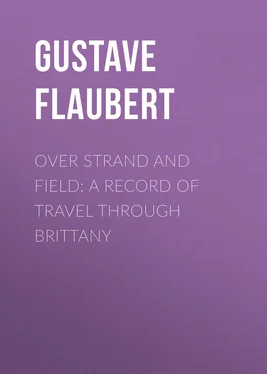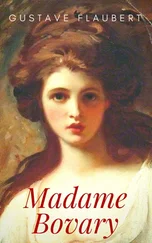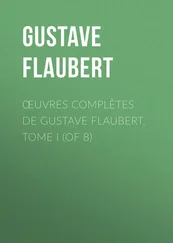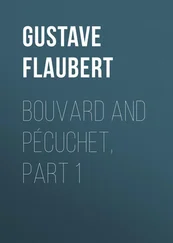Gustave Flaubert - Over Strand and Field - A Record of Travel through Brittany
Здесь есть возможность читать онлайн «Gustave Flaubert - Over Strand and Field - A Record of Travel through Brittany» — ознакомительный отрывок электронной книги совершенно бесплатно, а после прочтения отрывка купить полную версию. В некоторых случаях можно слушать аудио, скачать через торрент в формате fb2 и присутствует краткое содержание. Жанр: foreign_antique, foreign_prose, на английском языке. Описание произведения, (предисловие) а так же отзывы посетителей доступны на портале библиотеки ЛибКат.
- Название:Over Strand and Field: A Record of Travel through Brittany
- Автор:
- Жанр:
- Год:неизвестен
- ISBN:нет данных
- Рейтинг книги:3 / 5. Голосов: 1
-
Избранное:Добавить в избранное
- Отзывы:
-
Ваша оценка:
- 60
- 1
- 2
- 3
- 4
- 5
Over Strand and Field: A Record of Travel through Brittany: краткое содержание, описание и аннотация
Предлагаем к чтению аннотацию, описание, краткое содержание или предисловие (зависит от того, что написал сам автор книги «Over Strand and Field: A Record of Travel through Brittany»). Если вы не нашли необходимую информацию о книге — напишите в комментариях, мы постараемся отыскать её.
Over Strand and Field: A Record of Travel through Brittany — читать онлайн ознакомительный отрывок
Ниже представлен текст книги, разбитый по страницам. Система сохранения места последней прочитанной страницы, позволяет с удобством читать онлайн бесплатно книгу «Over Strand and Field: A Record of Travel through Brittany», без необходимости каждый раз заново искать на чём Вы остановились. Поставьте закладку, и сможете в любой момент перейти на страницу, на которой закончили чтение.
Интервал:
Закладка:
Gustave Flaubert
Over Strand and Field: A Record of Travel through Brittany
OVER STRAND AND FIELD 1 1 Gustave Flaubert was twenty-six years old when he started on this journey. He travelled on foot and was accompanied by M. Maxime Ducamp. When they returned, they wrote an account of their journey. It is by far the most important of the unpublished writings, for in it the author gives his personal genius full sway and it abounds in picturesque descriptions and historical reflections.
CHAPTER I.
CHÂTEAU DE CHAMBORD
We walked through the empty galleries and deserted rooms where spiders spin their cobwebs over the salamanders of Francis the First. One is overcome by a feeling of distress at the sight of this poverty which has no grandeur. It is not absolute ruin, with the luxury of blackened and mouldy débris, the delicate embroidery of flowers, and the drapery of waving vines undulating in the breeze, like pieces of damask. It is a conscious poverty, for it brushes its threadbare coat and endeavours to appear respectable. The floor has been repaired in one room, while in the next it has been allowed to rot. It shows the futile effort to preserve that which is dying and to bring back that which has fled. Strange to say, it is all very melancholy, but not at all imposing.
And then it seems as if everything had contributed to injure poor Chambord, designed by Le Primatice and chiselled and sculptured by Germain Pilon and Jean Cousin. Upreared by Francis the First, on his return from Spain, after the humiliating treaty of Madrid (1526), it is the monument of a pride that sought to dazzle itself in order to forget defeat. It first harbours Gaston d'Orléans, a crushed pretender, who is exiled within its walls; then it is Louis XIV, who, out of one floor, builds three, thus ruining the beautiful double staircase which extended without interruption from the top to the bottom. Then one day, on the second floor, facing the front, under the magnificent ceiling covered with salamanders and painted ornaments which are now crumbling away, Molière produced for the first time Le Bourgeois gentilhomme . Then it was given to the Maréchal de Saxe; then to the Polignacs, and finally to a plain soldier, Berthier. It was afterwards bought back by subscription and presented to the Duc de Bordeaux. It has been given to everybody, as if nobody cared to have it or desired to keep it. It looks as if it had hardly ever been used, and as if it had always been too spacious. It is like a deserted hostelry where transient guests have not left even their names on the walls.
When we walked through an outside gallery to the Orléans staircase, in order to examine the caryatids which are supposed to represent Francis the First, M. de Chateaubriand, and Madame d'Étampes, and turned around the celebrated lantern that terminates the big staircase, we stuck our heads several times through the railing to look down. In the courtyard was a little donkey nursing its mother, rubbing up against her, shaking its long ears and playfully jumping around. This is what we found in the court of honour of the Château de Chambord; these are its present hosts: a dog rolling in the grass, and a nursing, braying donkey frolicking on the threshold of kings!
The Château d'Amboise, which dominates the whole city that appears to be thrown at its feet like a mass of pebbles at the foot of a rock, looks like an imposing fortress, with its large towers pierced by long, narrow windows; its arched gallery that extends from the one to the other, and the brownish tint of its walls, darkened by the contrast of the flowers, which droop over them like a nodding plume on the bronzed forehead of an old soldier. We spent fully a quarter of an hour admiring the tower on the left; it is superb, imbrowned and yellowish in some places and coated with soot in others; it has charming charlocks hanging from its battlements, and is, in a word, one of those speaking monuments that seem to breathe and hold one spellbound and pensive under their gaze, like those paintings, the originals of which are unknown to us, but whom we love without knowing why.
The Château is reached by a slight incline which leads to a garden elevated like a terrace, from which the view extends on the whole surrounding country. It was of a delicate green; poplar trees lined the banks of the river; the meadows advanced to its edge, mingling their grey border with the bluish and vapourous horizon, vaguely enclosed by indistinct hills. The Loire flowed in the middle, bathing its islands, wetting the edge of the meadows, turning the wheels of the mills and letting the big boats glide peacefully, two by two, over its silvery surface, lulled to sleep by the creaking of the heavy rudders; and in the distance two big white sails gleamed in the sun.
Birds flew from the tops of the towers and the edge of the machicolations to some other spot, described circles in the air, chirped, and soon passed out of sight. About a hundred feet below us were the pointed roofs of the city, the empty courtyards of the old mansions, and the black holes of the smoky chimneys. Leaning in the niche of a battlement, we gazed and listened, and breathed it all in, enjoying the beautiful sunshine and balmy air impregnated with the pungent odour of the ruins. And there, without thinking of anything in particular, without even phrasing inwardly about something, I dreamed of coats of mail as pliable as gloves, of shields of buffalo hide soaked with sweat, of closed visors through which shot bloodthirsty glances, of wild and desperate night attacks with torches that set fire to the walls, and hatchets that mutilated the bodies; and of Louis XI, of the lover's war, of D'Aubigné and of the charlocks, the birds, the polished ivy, the denuded brambles, tasting in my pensive and idle occupation – what is greatest in men, their memory; – and what is most beautiful in nature, her ironical encroachments and eternal youth.
In the garden, among the lilac-bushes and the shrubs that droop over the alleys, rises the chapel, a work of the sixteenth century, chiselled at every angle, a perfect jewel, even more intricately decorated inside than out, cut out like the paper covering of a bonbonnière , and cunningly sculptured like the handle of a Chinese parasol. On the door is a bas-relief which is very amusing and ingenuous. It represents the meeting of Saint Hubert with the mystic stag, which bears a cross between its antlers. The saint is on his knees; above him hovers an angel who is about to place a crown on his cap; near them stands the saint's horse, watching the scene with a surprised expression; the dogs are barking and on the mountain, the sides and facets of which are cut to represent crystals, creeps the serpent. You can see its flat head advancing toward some leafless trees that look like cauliflowers. They are the sort of trees one comes upon in old Bibles, spare of foliage, thick and clumsy, bearing blossoms and fruit but no leaves; the symbolical, theological, and devout trees that are almost fantastical on account of their impossible ugliness. A little further, Saint Christopher is carrying Jesus on his shoulders; Saint Antony is in his cell, which is built on a rock; a pig is retiring into its hole and shows only its hind-quarters and its corkscrew tail, while a rabbit is sticking its head out of its house.
Of course, it is all a little clumsy and the moulding is not faultless. But there is so much life and movement about the figure and the animals, so much charm in the details, that one would give a great deal to be able to carry it away and take it home.
Inside of the Château, the insipid Empire style is reproduced in every apartment. Almost every room is adorned with busts of Louis-Philippe and Madame Adélaïde. The present reigning family has a craze for being portrayed on canvas. It is the bad taste of a parvenu, the mania of a grocer who has accumulated money and who enjoys seeing himself in red, white, and yellow, with his watch-charms dangling over his stomach, his bewhiskered chin and his children gathered around him.
Читать дальшеИнтервал:
Закладка:
Похожие книги на «Over Strand and Field: A Record of Travel through Brittany»
Представляем Вашему вниманию похожие книги на «Over Strand and Field: A Record of Travel through Brittany» списком для выбора. Мы отобрали схожую по названию и смыслу литературу в надежде предоставить читателям больше вариантов отыскать новые, интересные, ещё непрочитанные произведения.
Обсуждение, отзывы о книге «Over Strand and Field: A Record of Travel through Brittany» и просто собственные мнения читателей. Оставьте ваши комментарии, напишите, что Вы думаете о произведении, его смысле или главных героях. Укажите что конкретно понравилось, а что нет, и почему Вы так считаете.












